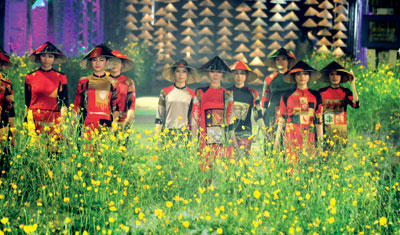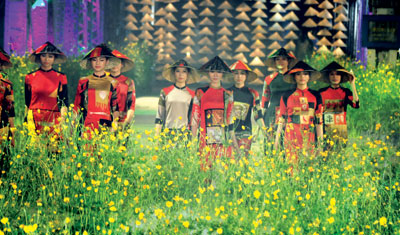(No.3, Vol.7,Jun-Jul 2017 Vietnam Heritage Magazine)

Collections showcased at the ao dai night.
Photo: Hue Phong
A Hue girl by Ton That Dao
Photo Vietnam Fine Arts Association.

Designer Hien Dang, Dao’s daughter-in-law Lien Phuong, and Dao’s granddaughter Hang (left to right) wear ao dai printed with his paintings at the show.
Photo Nguyen Quy

The painting Sông H??ng núi Ng? by Ton That Dao.
Photo Hue Phong.
With deep love for Hue veteran painters, Minh Hanh and her fellow designers held a catwalk night in April showcasing Vietnam’s traditional ao dai with copies of paintings of the artists printed on the costume’s flaps.
The successful show entertained locals in the former imperial capital and has sparked a call for help to the family of a late artist. It was a Sunday night when thousands of people of different ages flocked to the city’s iconic bridge. Traffic on Truong Tien Bridge, where the show’s stage and stands for the audience were erected, was blocked before and during the show.
The empty roads were decorated with hanging conical hats and fresh flower plants, transforming the entire area into an open grand stage. With those decorations, models wearing the national costume walked out and around, looking just like they were walking in a peaceful, colourful garden.
The combination of ao dai and Hue’s beloved painters led to a new concept of performing arts, enthralling both fashion designers and local audiences. The show was the much-awaited costume performances in the city, as months ago, Hue residents heard of the special ao dai collection.
Songs by the late composer Trinh Cong Son, also a Hue native, inspired the catwalks for the first collection of the show. Designer Hien Dang introduced her collection with the costume flaps printed with copies of paintings by late artist Ton That Dao. Many among the audiences showed excitement watching the collection, but actually, they did not know who the late artist was. This reflected the oblivious condition towards the country’s prominent silk painters.
‘It is really painful to see excellent paintings on silk left forgotten,’ Hien said and determined that her collection would not remind people of the heritage but would create a call for help from the media.
Born in 1910 to a family that had royal connections and bore Confucian traditions, Ton That Dao showed strong keenness for painting during childhood. In 1932, Dao was accepted to the Indochinese College of Arts, the only art academy in Indochina set up and run by the French.
He graduated in 1937 and started teaching painting in several schools in Hue. He also painted on silk at that time. Thanks to his talent and prestige, Saigon’s government assigned him to form Hue College of Arts in 1957. He was also the first rector of the college that today exists under the name of Hue University of Arts.
Before he passed away in 1979, Dao was teaching hundreds of painters. He was also a prominent silk painter in Vietnam, leaving behind more than 100 paintings. His outstanding works included Sông H??ng núi Ng? (Huong River and Ngu mountain), Thi?u n? Hu? (A young Hue girl) and Sen tr?ng (White lotus flower).
Dao also painted with oil and canvas. He won a lot of art competitions in Hanoi, Hue, Saigon, Thailand, Japan and the Vatican. The French and Vatican had awarded him with medals for his contribution of art.
However, Dao’s family could not enjoy his success after he died. His first son was bedridden, and he had an unemployed wife, a paralyzed son, and a daughter. Another of Dao’s sons died young in the US and his daughter lives in the US with earnings enough for only herself.
Lien Phuong, daughter-in-law of the artist, said none of his descendants have enough knowledge to protect the paintings. ‘We can’t afford enough for conservation,’ she said, adding that she and her daughter are the only healthy persons in the family; they are experiencing a hard life taking care of other two paralyzed people, and trying to earn a living at the same time.
‘It’s painful to see my father’s heritage going to ruin. But selling them all would be offensive.’
Phuong also has no legal base to donate the paintings to an art institute or a museum in an attempt to keep the artwork conserved. About 40 among 100 works by the artist are left in Hue. Some are preserved at private museums both in the country and abroad. Some others wander somewhere else in the world, as museums came to borrow them and they have never returned them, according to Phuong.
At Dao’s home, the paintings hanging on the walls include valuable paintings of Sông H??ng núi Ng?, V??n xuân (A Spring garden), Chân dung c? già (Portrait of an old man), and Phong c?nh thôn quê (Countryside scene). Dao painted these in the country’s history difficult period from 1945-1965.
All the paintings are in bad condition. Some are encased in frames turned almost to dust because of woodworms. In others, the silk itself is tattered and fading or covered in thick layers of dust.
Designer Hien said she spent almost a month working on the photographs capturing the paintings due to shady and low resolution. ‘The paintings absorb humidity and become vague. It was really hard for photographers to capture them,’ she said.
But this suggests the critical ruin condition of these rare paintings. Losing them would mean losing part of the country’s silk painting history.
Many of Dao’s former students have raised calls for the noble lecturer’s works. But local culture authorities seem to be reluctant to respond. Meanwhile, Dao’s descendants live largely from donations and the small earnings their daughter earns as a librarian.
The city department has proposed a museum road in Hue that would embrace multiple museums, including the key one – Hue Museum of Arts. This museum is expected to adopt Dao’s paintings and connect them to skilled researchers around the world for their help.
However, for almost a year now, the project has stood still and only the project sections with investment from the private sector go on. The ao dai fashion show seems to be the first ever move conducted in Hue to memorise and honour the outstanding painter Dao.
By listing his paintings in the must-to-do of the reprinting paintings on the costume flaps and allowing the collection with his paintings to appear the earliest in the show, the designers have reminded the art community in Hue particular and in Vietnam in general that Dao is always in art history. He had served as a prestige pioneer and the younger artist generations should look to the protection over the priceless paintings.

